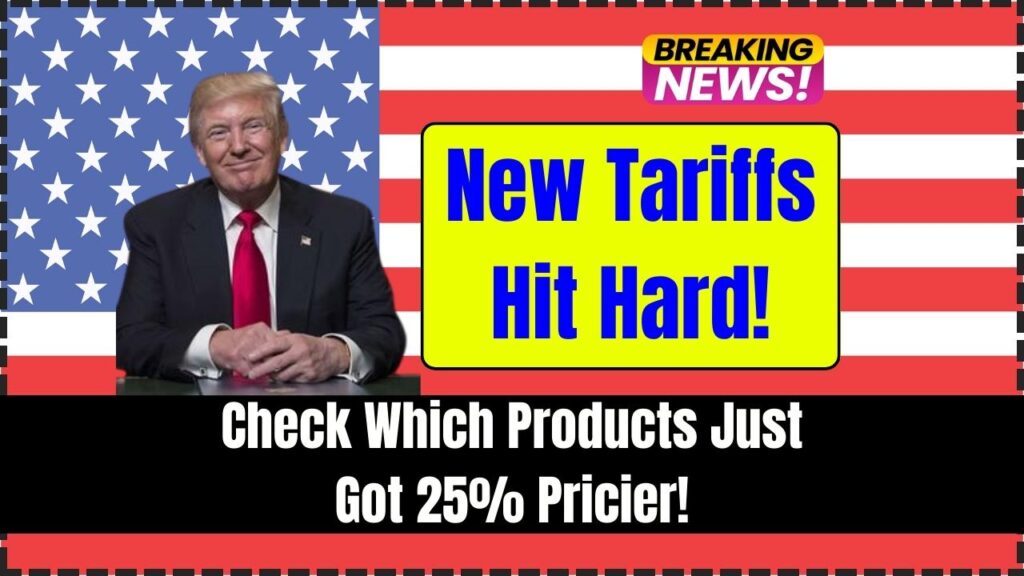
New Tariffs Hit Hard: In April 2025, new tariffs introduced by the United States government have reshaped the economy by making hundreds of imported products up to 25% more expensive. From automobiles and construction materials to pharmaceuticals and clothing, these price hikes are already affecting American families and businesses. Whether you’re a consumer planning your next big purchase or a business owner managing costs, it’s essential to understand how these tariffs work, what’s impacted, and what you can do about it. This article explains everything in a clear, approachable way, offering practical advice for dealing with these new changes.
New Tariffs Hit Hard
The new 2025 tariffs are already reshaping how Americans shop, build, and do business. While the intent is to protect domestic industries, the broader economic effects are undeniable: higher prices, tighter budgets, and global trade disruptions. Staying informed and adjusting your strategies—whether as a consumer or a professional—will be key to weathering this economic shift. By understanding what’s affected, taking proactive steps, and seeking reliable information, you can navigate these changes smartly and effectively.
| Category | Details |
|---|---|
| Tariff Rates | 25% on cars, car parts, steel, aluminum, and more; up to 145% on Chinese goods. |
| Industries Affected | Automotive, construction, pharmaceuticals, clothing, consumer electronics. |
| Consumer Impact | Average household faces over $2,100 in additional yearly costs |
| Global Trade Response | Retaliatory tariffs from China, Mexico, and Canada; potential global supply chain disruptions. |
| Official Resources | U.S. Customs and Border Protection and White House Fact Sheets. |
What Triggered the New 2025 Tariffs?
The new tariffs were introduced as part of a broader economic strategy to protect American industries and reduce the trade deficit. However, they have sparked both national and international debate.
In March 2025, President Trump signed an executive order declaring a “national economic emergency.” This order allowed the administration to quickly impose new tariffs, particularly on goods from China and countries outside the USMCA agreement (United States-Mexico-Canada Agreement).
The tariffs are intended to:
- Encourage domestic production.
- Penalize countries accused of unfair trade practices.
- Protect industries deemed vital for national security.
However, many economists warn that tariffs can also increase costs for businesses and consumers, fueling inflation.
Timeline of Events
- March 5, 2025: Executive Order announced.
- April 1, 2025: 25% tariffs on steel, aluminum, cars, and car parts go into effect.
- April 15, 2025: New tariffs on electronics, pharmaceuticals, clothing, and toys are announced.
- May 3, 2025: Tariffs on automotive components, generic drugs, and additional goods begin enforcement.
Industries and Products Most Affected
Automotive Sector
The automotive industry has been hit hard. Imported cars now carry a 25% surcharge unless sourced from USMCA-compliant countries. Even American-made vehicles are affected because many auto parts come from overseas. According to Reuters, major automakers like Ford and GM have warned of higher vehicle prices and potential job cuts.
Construction and Housing
Builders are paying more for steel, aluminum, and lumber. The National Association of Home Builders reports that the cost of an average new home could rise by $10,000 to $15,000 due to material tariffs.
Pharmaceuticals
Generic drugs are particularly vulnerable. The Financial Times reports that tariffs on active pharmaceutical ingredients could cost Americans an additional $51 billion annually in drug prices.
Apparel and Consumer Goods
Clothing prices have surged, with increases of about 17% on average. Low-cost electronics, toys, and even school supplies are seeing double-digit price hikes, affecting both households and small businesses.
Expert Opinions on the New Tariffs
Dr. Laura Tyson, former Chair of the U.S. President’s Council of Economic Advisers, commented in an interview with CNBC that “tariffs are effectively a tax on consumers” and warned that they could exacerbate inflation already running high in the U.S.
Meanwhile, supporters like Peter Navarro, former White House Trade Advisor, argue that “short-term pain” will lead to “long-term gain” by rebuilding critical industries in America.
How to Deal With the New Tariffs Hit Hard: A Practical Guide
Step 1: Budget Smartly
Identify products likely to rise in price. Adjust your budget to account for a 5–10% overall increase in consumer goods.
Step 2: Buy Domestic
Whenever possible, choose American-made products. They might be slightly more expensive upfront, but often save you from additional tariff-induced markups.
Step 3: Bulk Purchase
Buy non-perishable goods like electronics, clothing, and building materials sooner rather than later to avoid future price hikes.
Step 4: For Businesses: Diversify Your Supply Chain
If you own a business, it’s crucial to find alternative suppliers in countries not subject to these tariffs or invest in local sourcing.
Federal Resignation Program Under Trump Moves Ahead After Legal Victory
Trump’s Tariffs Trigger Market Bloodbath in Asia – What’s Really Happening?
Tariffs Force Major Layoffs at 5 US Auto Factories – Here’s Why!
Frequently Asked Questions (FAQs)
Q1: Are all imported products subject to tariffs?
No. Products from USMCA partners (Canada, Mexico) are mostly exempt if they meet specific rules of origin. However, goods from China and many other countries face steep tariffs.
Q2: How much will the average consumer pay due to these tariffs?
According to BudgetLab at Yale, households may face over $2,100 in extra annual costs.
Q3: Can businesses apply for tariff exemptions?
Yes. Businesses can petition the U.S. Trade Representative’s office for product exclusions under specific circumstances.
Q4: What are retaliatory tariffs?
Countries like China, Mexico, and Canada have imposed their own tariffs on American goods such as agricultural products, raising tensions and prices further.








